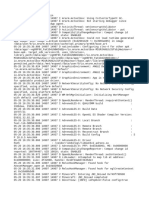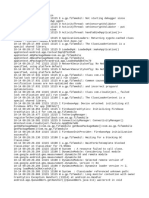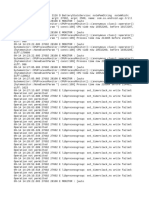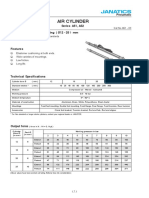0 ratings0% found this document useful (0 votes)
220 viewsLimbo Log
Limbo Log
Uploaded by
Edwin LCThis document contains log messages from an Android application crash. It shows:
1) The application crashed with a SIGSEGV fault due to attempting to access an invalid memory address.
2) The application was attempting to start a QEMU virtual machine on an Android device using a Windows 7 virtual disk image file.
3) The QEMU process failed to initialize guest memory for the virtual machine due to running out of memory on the Android device.
Copyright:
© All Rights Reserved
Available Formats
Download as TXT, PDF, TXT or read online from Scribd
Limbo Log
Limbo Log
Uploaded by
Edwin LC0 ratings0% found this document useful (0 votes)
220 views2 pagesThis document contains log messages from an Android application crash. It shows:
1) The application crashed with a SIGSEGV fault due to attempting to access an invalid memory address.
2) The application was attempting to start a QEMU virtual machine on an Android device using a Windows 7 virtual disk image file.
3) The QEMU process failed to initialize guest memory for the virtual machine due to running out of memory on the Android device.
Copyright
© © All Rights Reserved
Available Formats
TXT, PDF, TXT or read online from Scribd
Share this document
Did you find this document useful?
Is this content inappropriate?
This document contains log messages from an Android application crash. It shows:
1) The application crashed with a SIGSEGV fault due to attempting to access an invalid memory address.
2) The application was attempting to start a QEMU virtual machine on an Android device using a Windows 7 virtual disk image file.
3) The QEMU process failed to initialize guest memory for the virtual machine due to running out of memory on the Android device.
Copyright:
© All Rights Reserved
Available Formats
Download as TXT, PDF, TXT or read online from Scribd
Download as txt, pdf, or txt
0 ratings0% found this document useful (0 votes)
220 views2 pagesLimbo Log
Limbo Log
Uploaded by
Edwin LCThis document contains log messages from an Android application crash. It shows:
1) The application crashed with a SIGSEGV fault due to attempting to access an invalid memory address.
2) The application was attempting to start a QEMU virtual machine on an Android device using a Windows 7 virtual disk image file.
3) The QEMU process failed to initialize guest memory for the virtual machine due to running out of memory on the Android device.
Copyright:
© All Rights Reserved
Available Formats
Download as TXT, PDF, TXT or read online from Scribd
Download as txt, pdf, or txt
You are on page 1of 2
--------- beginning of crash
06-13 14:24:06.096 11475 11496 F libc : Fatal signal 11 (SIGSEGV), code 1
(SEGV_MAPERR), fault addr 0x0 in tid 11496 (RenderThread), pid 11475
(.limbo.emu.main)
--------- beginning of system
06-13 14:24:31.574 11540 11579 I Timeline: Timeline: Activity_launch_request
time:8547274
--------- beginning of main
06-13 14:24:31.588 11540 11540 I Toast : Show toast from
OpPackageName:com.limbo.emu.main, PackageName:com.limbo.emu.main
06-13 14:24:31.619 11540 11540 V SDL : Device: vayu
06-13 14:24:31.619 11540 11540 V SDL : Model: M2102J20SG
06-13 14:24:31.619 11540 11540 V SDL : onCreate(): null
06-13 14:24:31.624 11540 11540 V SDL : Max Mem = 536870912
06-13 14:24:31.630 11540 11540 V SDLSurface: Got New Surface
06-13 14:24:31.640 11540 11540 V SDL : onResume()
06-13 14:24:31.641 11540 11540 V SDL : onResume()
06-13 14:24:31.641 11540 11540 V SDL : HandleResume
06-13 14:24:31.642 11540 11587 E SDL_androidtouch.c: No Android Window!
06-13 14:24:31.664 11540 11540 D SurfaceView: UPDATE null, mIsCastMode = false
06-13 14:24:31.665 11540 11540 V SDL : surfaceCreated()
06-13 14:24:31.666 11540 11540 V SDL : surfaceChanged(1080x1004)
06-13 14:24:31.666 11540 11540 V SDL : pixel format RGB_565
06-13 14:24:31.666 11540 11540 V Limbo : Surface Hardware Acceleration: true
06-13 14:24:31.666 11540 11540 V SDL : Window size: 1080x1004
06-13 14:24:31.673 11540 11589 I SDL : SDL_Android_Init()
06-13 14:24:31.673 11540 11540 V SDL : HandleResume
06-13 14:24:31.673 11540 11589 I SDL : SDL_Android_Init() finished!
06-13 14:24:31.674 11540 11585 W GLSurfaceView: Warning, !readyToDraw() but waiting
for draw finished! Early reporting draw finished.
06-13 14:24:31.676 11540 11589 V VMExecutor: startVMService
06-13 14:24:31.688 11540 11540 D SurfaceView: UPDATE Surface(name=SurfaceView -
com.limbo.emu.main/com.max2idea.android.limbo.main.LimboSDLActivity)/@0x76803af,
mIsProjectionMode = false
06-13 14:24:31.691 11540 11540 D LimboService: debug: Creating LimboService
06-13 14:24:31.691 11540 11540 D LimboService: Received ACTION_URL
06-13 14:24:31.693 11540 11540 W Notification: Use of stream types is deprecated
for operations other than volume control
06-13 14:24:31.693 11540 11540 W Notification: See the documentation of setSound()
for what to use instead with android.media.AudioAttributes to qualify your playback
use case
06-13 14:24:31.696 11540 11540 V LimboService: Starting the VM
06-13 14:24:31.700 11540 11540 I SDL_android.c: JNI_OnLoad called
06-13 14:24:31.702 11540 11540 I FeatureParser: can't find vayu.xml in
assets/device_features/,it may be in /vendor/etc/device_features
06-13 14:24:31.705 11540 11540 E libc : Access denied finding property
"ro.vendor.df.effect.conflict"
06-13 14:24:31.705 11540 11540 E libc : Access denied finding property
"ro.vendor.knock.type"
06-13 14:24:31.706 11540 11597 V VMExecutor: Disabling VNC server, using SDL
instead
06-13 14:24:31.707 11540 11597 V vm-executor-jni.cpp: ***** INIT LIMBO VARS *****
06-13 14:24:31.707 11540 11597 V vm-executor-jni.cpp: Setting Params
06-13 14:24:31.707 11540 11597 V vm-executor-jni.cpp: QEMU
param[0]=/data/user/0/com.limbo.emu.main/lib/libqemu-system-x86_64.so
06-13 14:24:31.707 11540 11597 V vm-executor-jni.cpp: QEMU param[1]=-m
06-13 14:24:31.707 11540 11597 V vm-executor-jni.cpp: QEMU param[2]=1000
06-13 14:24:31.707 11540 11597 V vm-executor-jni.cpp: QEMU param[3]=-L
06-13 14:24:31.707 11540 11597 V vm-executor-jni.cpp: QEMU
param[4]=/storage/emulated/0/limbo/
06-13 14:24:31.707 11540 11597 V vm-executor-jni.cpp: QEMU param[5]=-hda
06-13 14:24:31.707 11540 11597 V vm-executor-jni.cpp: QEMU
param[6]=/storage/emulated/0/limbo/machines/Windows 7/Windows 7.qcow2
06-13 14:24:31.707 11540 11597 V vm-executor-jni.cpp: QEMU param[7]=-cdrom
06-13 14:24:31.707 11540 11597 V vm-executor-jni.cpp: QEMU
param[8]=/content//com.android.providers.downloads.documents/document/msf%3A8974
06-13 14:24:31.707 11540 11597 V vm-executor-jni.cpp: QEMU param[9]=-vga
06-13 14:24:31.707 11540 11597 V vm-executor-jni.cpp: QEMU param[10]=std
06-13 14:24:31.707 11540 11597 V vm-executor-jni.cpp: QEMU param[11]=-net
06-13 14:24:31.707 11540 11597 V vm-executor-jni.cpp: QEMU param[12]=user
06-13 14:24:31.707 11540 11597 V vm-executor-jni.cpp: QEMU param[13]=-net
06-13 14:24:31.707 11540 11597 V vm-executor-jni.cpp: QEMU
param[14]=nic,model=rtl8139
06-13 14:24:31.707 11540 11597 V vm-executor-jni.cpp: QEMU param[15]=-qmp
06-13 14:24:31.707 11540 11597 V vm-executor-jni.cpp: QEMU
param[16]=tcp:localhost:4444,server,nowait
06-13 14:24:31.707 11540 11597 V vm-executor-jni.cpp: QEMU param[17]=-k
06-13 14:24:31.707 11540 11597 V vm-executor-jni.cpp: QEMU param[18]=en-us
06-13 14:24:31.707 11540 11597 V vm-executor-jni.cpp: QEMU param[19]=-smp
06-13 14:24:31.707 11540 11597 V vm-executor-jni.cpp: QEMU param[20]=4
06-13 14:24:31.707 11540 11597 V vm-executor-jni.cpp: QEMU param[21]=-M
06-13 14:24:31.707 11540 11597 V vm-executor-jni.cpp: QEMU param[22]=pc
06-13 14:24:31.707 11540 11597 V vm-executor-jni.cpp: QEMU param[23]=-realtime
06-13 14:24:31.707 11540 11597 V vm-executor-jni.cpp: QEMU param[24]=mlock=off
06-13 14:24:31.707 11540 11597 V vm-executor-jni.cpp: QEMU param[25]=-rtc
06-13 14:24:31.707 11540 11597 V vm-executor-jni.cpp: QEMU param[26]=base=localtime
06-13 14:24:31.707 11540 11597 V vm-executor-jni.cpp: QEMU param[27]=-localtime
06-13 14:24:31.707 11540 11597 V vm-executor-jni.cpp: ***** INIT QEMU *****
06-13 14:24:31.707 11540 11597 V vm-executor-jni.cpp: Starting VM...
06-13 14:24:31.707 11540 11597 V vm-executor-jni.cpp: Loading lib:
/data/user/0/com.limbo.emu.main/lib/libqemu-system-x86_64.so
06-13 14:24:31.691 11540 11540 W .limbo.emu.main: type=1400 audit(0.0:25070): avc:
denied { read } for name="u:object_r:vendor_displayfeature_prop:s0" dev="tmpfs"
ino=10149 scontext=u:r:untrusted_app_25:s0:c512,c768
tcontext=u:object_r:vendor_displayfeature_prop:s0 tclass=file permissive=0
app=com.limbo.emu.main
06-13 14:24:31.707 11540 11597 V vm-executor-jni.cpp: Loading symbol qemu_start...
06-13 14:24:31.711 11540 11597 D vl.c:3458: Storing
limbo_base_dir=/storage/emulated/0/limbo/
06-13 14:24:31.733 11540 11608 I limbo_compat_fd.c: get_fd:
/content//com.android.providers.downloads.documents/document/msf%3A8974
06-13 14:24:31.738 11540 11608 I limbo_compat_fd.c: Loaded file: 129,
/content//com.android.providers.downloads.documents/document/msf%3A8974
06-13 14:24:31.740 11540 11610 I limbo_compat_fd.c: get_fd:
/content//com.android.providers.downloads.documents/document/msf%3A8974
06-13 14:24:31.742 11540 11587 E SDL_androidtouch.c: No Android Window!
06-13 14:24:31.745 11540 11540 V SDL : onWindowFocusChanged(): true
06-13 14:24:31.745 11540 11540 V SDL : HandleResume
06-13 14:24:31.754 11540 11610 I limbo_compat_fd.c: Loaded file: 129,
/content//com.android.providers.downloads.documents/document/msf%3A8974
06-13 14:24:31.758 11540 11597 E error.c : cannot set up guest memory 'pc.ram': Out
of memory
06-13 14:24:31.760 11540 11593 F libc : Fatal signal 11 (SIGSEGV), code 1
(SEGV_MAPERR), fault addr 0x4 in tid 11593 (InsetsAnimation), pid 11540
(.limbo.emu.main)
You might also like
- Call Fiche - Erasmus Edu 2024 Pol Exp - enDocument56 pagesCall Fiche - Erasmus Edu 2024 Pol Exp - enAna Cristina NistorNo ratings yet
- LogDocument67 pagesLogRudhi Al GhaisanNo ratings yet
- LogDocument7 pagesLogKent Ceasar NavarroNo ratings yet
- LogDocument163 pagesLogM Fahmi AmaruddinNo ratings yet
- LogDocument5 pagesLogJames KurtzNo ratings yet
- Log Com - Gameloft.android - anmp.GloftA3HM 1666886069Document7 pagesLog Com - Gameloft.android - anmp.GloftA3HM 1666886069Oyekunle GbohunmiNo ratings yet
- LimbologDocument2 pagesLimbologbarath6546No ratings yet
- LogDocument26 pagesLogEfya KaishaNo ratings yet
- Logcat 1636529214253Document37 pagesLogcat 1636529214253Elza Laku6No ratings yet
- Mod Menu Log - Com - Bandainamcoent.dblegends - WWDocument25 pagesMod Menu Log - Com - Bandainamcoent.dblegends - WWdragonballgaming47No ratings yet
- LogDocument34 pagesLogUm RandomNo ratings yet
- Inbound 6545590321110485502Document163 pagesInbound 6545590321110485502petitpenterNo ratings yet
- LogDocument27 pagesLograntokosongtujuhNo ratings yet
- LogDocument11 pagesLogsalmanparis972No ratings yet
- LaguDocument37 pagesLagumarianuslebi067No ratings yet
- PyrtleDocument193 pagesPyrtleMattias BörjessonNo ratings yet
- Log Cat 1626166395904Document48 pagesLog Cat 1626166395904Reni MelindaNo ratings yet
- LogDocument5 pagesLogmalaggayivyjaneNo ratings yet
- Log Com - Roblox.client 1686918755Document328 pagesLog Com - Roblox.client 1686918755HarisNo ratings yet
- Toolbox Log SnapshotDocument166 pagesToolbox Log Snapshothaeseunggil6No ratings yet
- LogDocument8 pagesLogblue jhonNo ratings yet
- LogDocument13 pagesLogWahono Bagoes Adjie WibowoNo ratings yet
- LogDocument110 pagesLogtitiswahyuningsih01No ratings yet
- LogDocument24 pagesLogujang kilauNo ratings yet
- LogDocument5 pagesLogGalih harun alfajriNo ratings yet
- LogDocument3 pagesLogsyafitrif906No ratings yet
- LogDocument1,708 pagesLogokorieebuka70No ratings yet
- مخطوط روماني قدبمDocument152 pagesمخطوط روماني قدبمYusef SifNo ratings yet
- LogDocument28 pagesLogJudith JabalNo ratings yet
- LogDocument5 pagesLogMar TinNo ratings yet
- Log Com - Gameloft.android - anmp.GloftA3HM 1687358595Document308 pagesLog Com - Gameloft.android - anmp.GloftA3HM 1687358595Avwerosuo OnajiteNo ratings yet
- LogDocument60 pagesLogumickp72No ratings yet
- LogDocument11 pagesLogazzukruffitriyaniNo ratings yet
- LogcatDocument26 pagesLogcatmmcgamer47No ratings yet
- Mod Menu Log - Com - Ea.gp - FifamobileDocument209 pagesMod Menu Log - Com - Ea.gp - Fifamobileيوسف ايادNo ratings yet
- AdblogcatDocument14 pagesAdblogcatHema ArumugamNo ratings yet
- LogDocument12 pagesLogDther AbordeNo ratings yet
- LogDocument9,929 pagesLogAfdalu Dzikri Arif RachmanNo ratings yet
- LogDocument6,138 pagesLogKrisha TiongcoNo ratings yet
- LogDocument17 pagesLogbagus setiadiNo ratings yet
- LogDocument47 pagesLogameliaanadiaNo ratings yet
- Logcat 1713161660211Document4 pagesLogcat 1713161660211radnapambNo ratings yet
- Standby Android Log 2024 1013 155316Document721 pagesStandby Android Log 2024 1013 155316Atahualpa EscorciaNo ratings yet
- Realme RMX3511 RE87BAL1 2023-06-15 21-23-39Document7 pagesRealme RMX3511 RE87BAL1 2023-06-15 21-23-39Nita AnggihNo ratings yet
- LogDocument166 pagesLogOmar MalekNo ratings yet
- IndexDocument5 pagesIndexsetiaefendi60No ratings yet
- LogDocument6 pagesLogDhini DiraNo ratings yet
- LogDocument20 pagesLogBcates BcatesNo ratings yet
- Log Cat 1721020714596Document39 pagesLog Cat 1721020714596aungzayar9424No ratings yet
- LogDocument124 pagesLogDeo Digna Aurelia SumelNo ratings yet
- LogDocument11 pagesLogRzNo ratings yet
- LogDocument52 pagesLogAtika AsriNo ratings yet
- Log Cat 1706686135444Document23 pagesLog Cat 1706686135444yonzonjohnrobert95No ratings yet
- MainDocument215 pagesMainmartin_b92029147No ratings yet
- Logcat 1592360150178Document16 pagesLogcat 1592360150178amelia.nurafitaaNo ratings yet
- LogcatDocument11,296 pagesLogcatzerifenagiyeva92No ratings yet
- Tslots LogcatDocument414 pagesTslots LogcatSimone SantosNo ratings yet
- Limbo LogDocument3 pagesLimbo LogRoxinni dawn SechongNo ratings yet
- LogDocument10 pagesLognoviza.olivia26No ratings yet
- Mod Menu LogDocument113 pagesMod Menu LogZulfikarNo ratings yet
- Citra Log - Txt.oldDocument8 pagesCitra Log - Txt.oldEdwin LCNo ratings yet
- x86 StderrDocument3 pagesx86 StderrEdwin LCNo ratings yet
- Citra LogDocument10 pagesCitra LogEdwin LCNo ratings yet
- Evaluation of Anxiety and Depression Prevalence in Patients With Primary Severe HyperhidrosisDocument6 pagesEvaluation of Anxiety and Depression Prevalence in Patients With Primary Severe HyperhidrosisEdwin LCNo ratings yet
- Gelbard Et Al-2008-Pediatric DermatologyDocument8 pagesGelbard Et Al-2008-Pediatric DermatologyEdwin LCNo ratings yet
- ResistanveDocument38 pagesResistanveAna Marie ValenzuelaNo ratings yet
- Dbdiagram IoDocument3 pagesDbdiagram IoА. ЛхагвасүрэнNo ratings yet
- Chapter 2: Equations, Inequalities and Absolute ValuesDocument14 pagesChapter 2: Equations, Inequalities and Absolute Valuesjokydin92No ratings yet
- Kinerja Bendung Pamarayan Daerah Irigasi Ciujung, Kabupaten SerangDocument6 pagesKinerja Bendung Pamarayan Daerah Irigasi Ciujung, Kabupaten SerangEvinGenellyNo ratings yet
- Automated Well Testing Package - Datasheet - 06.18Document2 pagesAutomated Well Testing Package - Datasheet - 06.18Jhon HernandezNo ratings yet
- 1-主机油料资料TD-1200-47-LO Chart included in technical data (approval drawing)Document7 pages1-主机油料资料TD-1200-47-LO Chart included in technical data (approval drawing)Aaron ChanNo ratings yet
- 3 PartsDocument27 pages3 PartsBappaditya AdhikaryNo ratings yet
- Avaya Call Reporting 4.2 Installation GuideDocument18 pagesAvaya Call Reporting 4.2 Installation GuideIvan Carrasco QuintanaNo ratings yet
- DAA - Ch. 1Document64 pagesDAA - Ch. 1xihafaf422No ratings yet
- Transportation Industry Experts Bill Vitti, David Mook and Matt Ruth Join The ISAAC Board of DirectorsDocument3 pagesTransportation Industry Experts Bill Vitti, David Mook and Matt Ruth Join The ISAAC Board of DirectorsPR.comNo ratings yet
- Internship ReportDocument52 pagesInternship ReportZainab SarfrazNo ratings yet
- Closures and Decorators SlidesDocument57 pagesClosures and Decorators SlidesciucdanielNo ratings yet
- Technical Specification - MCS LiteDocument6 pagesTechnical Specification - MCS LiteKrunoslavNo ratings yet
- 584 Forwarder Service Training: Haul More Load Faster Skid Longer Fell MoreDocument282 pages584 Forwarder Service Training: Haul More Load Faster Skid Longer Fell Morecjl08100% (1)
- PI 7.1 Messages Stuck Into The Queue of The Adapter Engine (DispatchDisp) - SAP Q&ADocument3 pagesPI 7.1 Messages Stuck Into The Queue of The Adapter Engine (DispatchDisp) - SAP Q&ASujith KumarNo ratings yet
- Chap02 - Using IT For Competitive AdvantageDocument32 pagesChap02 - Using IT For Competitive AdvantageAzizah SyarifNo ratings yet
- Dos and Don'ts For Writing MCQs 1.2Document8 pagesDos and Don'ts For Writing MCQs 1.2sudishettNo ratings yet
- Vapour and Combine Power CyclesDocument4 pagesVapour and Combine Power CyclesKishore KrishNo ratings yet
- SAfe QUestionsDocument12 pagesSAfe QUestionsFernando CruzNo ratings yet
- RCS Product Presentation v1 0 (11-MiTo3&Xlpora) 04 10 2016Document11 pagesRCS Product Presentation v1 0 (11-MiTo3&Xlpora) 04 10 2016임종원No ratings yet
- Criteria Points/Scores 5 4 3 2 1 Knowledge On The Subject MatterDocument2 pagesCriteria Points/Scores 5 4 3 2 1 Knowledge On The Subject MatterMichelle M. BagoNo ratings yet
- Raden R Bintang - Tugas 10 - PboDocument7 pagesRaden R Bintang - Tugas 10 - PboBintang PratomoNo ratings yet
- ITIL4 StakeDocument9 pagesITIL4 Stakeleonte.ioana4989100% (1)
- Lecture 5 White Box ApproachDocument140 pagesLecture 5 White Box Approachjohn michaelNo ratings yet
- Data Sheet of Bitumen 10/20Document1 pageData Sheet of Bitumen 10/20Iqra Angels100% (1)
- A51 A52 CylinderDocument6 pagesA51 A52 CylinderBiswanath LenkaNo ratings yet
- PertDocument34 pagesPertVikrant ChaudharyNo ratings yet
- Watching Digital Freeview TV On Monitor - Moni DTV-1200DT: Main FeaturesDocument1 pageWatching Digital Freeview TV On Monitor - Moni DTV-1200DT: Main FeaturesAlex DiedhiouNo ratings yet
- EBRO Ball CatalogDocument2 pagesEBRO Ball CatalogPEETIKUN TC-ENSTAGE.COMNo ratings yet






























































































